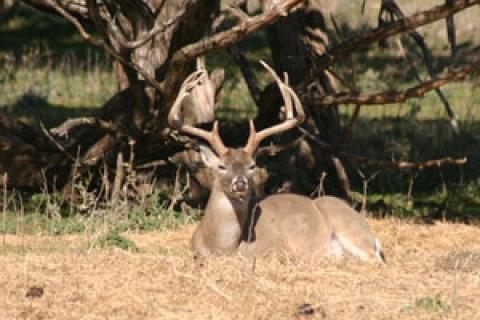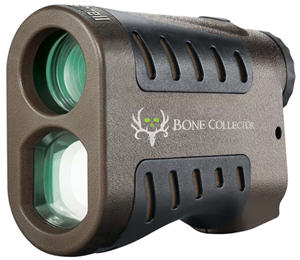
Most hunters firmly believe that pressured whitetails head deep into the dark forests, duck into the thickest brush found there, and hunker down and wait it out until hunting season passes. Being smart beasts (as nature intended), the deer know you'll be looking for them there, so they've moved.
Today's crafty deer are often found in places you overlook — the open areas that have been considered as prime rabbit and pheasant hunting grounds. The open fields have been viewed as totally void of deer. Today, more deer, including bucks, are definitely hiding in open grounds.
There Are Many Reasons for Whitetails to Hunker Down in Wide Open Spaces

The tall CRP (Conservation Reserve Program) or native grasses help hide bedded deer, but make it easy for them to raise their heads to see approaching hunters; in most cases, the open areas are closer to food sources, and foods attract does, and thus that's where the bucks want to be waiting and ready each fall; finally, overgrown fence rows and deep, brush-choked ditches threading through fields also offer up the dense cover that bucks seek when the hunting pressure increases.
All of these areas are often quickly by-passed by hunters who head for the forests and tall trees.
Is it Time to Change Your Hunting Tactics?
Maybe your next deer hunt should start across a seemingly deer-barren CRP field, in the weeds and brush around a cornfield, or along a creek that's twisting through an abandoned and over-grown farm field. Bucks are lurking there, and watching you walk and drive past. Go take a look, and be prepared to shoot.
Hunting the Open Ground Option

I first saw a hunter exploring "open ground" in eastern Colorado a few seasons past. He swore he'd been watching a nearby valley when he saw a buck walk up on a very open CRP grass-covered hillside and then bed. The hunter had glanced back often, and indicated he never saw the deer stand or leave. Then he asked would I help move the buck so he could possibly get a shot?

Rangefinder
That hunter simply drove around to the back of the hill, and found a place where he could watch a lot of the surrounding open ground. After a brief wait, I started walking exactly where he pointed into the head-tall grass. I was about 10 yards away when the buck exploded from its bed and dashed across the nearby hilltop. I caught brief glances of a white tail as the buck bounded up over the grasses, and then I heard a shot.
Tip: The Bushnell Bone Collector 850 Rangefinder is accurate out to 400 yards on non-reflective targets and 850 yards on reflective targets using infrared energy pulses similar to sonar. Operating on one 9V battery (included), this lightning-fast rangefinder is a must-have for trophy hunters.
The Hunter Saw an Opportunity
Seems the buck stepped into an open trail on the opposite side of the hill and my friend saw an opportunity when the buck paused to look back. I would have been among the many hunters who would have thought that there was no way any normal whitetail would even think about hiding in that grass. There were no trees around.
A Few Hunting Seasons Later

The point was driven home a few seasons later when a landowner told me to sit on her front porch if I wanted to get a big buck. Then, while I walked past to hunt in the distant woods up the valley behind her home, she told me an old crafty buck was walking through her yard and then hiding down by the creek in a thin ribbon of brush. It was several football field lengths across the open hayfields to the forests where I thought any decent deer would be hiding -- and found.
When I walked down to the creek to scout, I found tangles of honeysuckle and brush that opened with tunnels running underneath. Those deer were hidden once they moved into the drainage, and they felt safe. A few days later I climbed into a strategically placed hunting treestand where I could peer down into the brush and along the creek, and a short period later I spotted a deer. Along one of the well-worn trails came a buck that seemed to be carefree and content to hide in this small ribbon of cover. His hiding days were over when I settled the Bushnell rifle scope atop my Browning rifle.
Tip: For big game and predator hunting, as well as plinking the Bushnell Legend Rifle Scope repels water and fog for optimal clarity. This is scope accurate out to an impressive 500 yards, is lightweight and the body has an IPX7 waterproof rating. What's more, this scope is compatible with the Bushnell Ballistics smartphone app, allowing you to quickly determine exact distances for confident shot placement.
Pheasant Tactics Take Deer

hunters realize!
Hunters all across the Midwest are reporting the same events to me: as they hunt pheasants, they are jumping deer from beds in open areas. Most hunters express utter dismay! Overgrown fence rows, ditches along fields, and open grounds seem to be the new hangout for old bucks. Several of those hunters have also said they now walk — make that sneak at a snail's pace — along those areas to hunt deer with a firearm. You can too — with success.
The First Important Tactic for Hunting Success is to Pre-Scout
Study the brush from afar with a binocular or spotting scope. You might see only antler tips and never see a whole deer. It's to your advantage to know where a buck is bedded when possible. You can then better plan your approach, and predict how the buck might escape. This also lets you use the wind to your advantage. You don't want the wind to give away your scent and approach well before you arrive, or the deer will bolt and possibly never be seen. Most deer bed where they can see danger approaching from their front and smell danger approaching from their rear.
If You Have Friends Hunting With You, Play a Well-Known Pheasant Hunting Tactic

In addition to having someone on each side of a fence row or ditch also "post a blocker" at the far end. Much like pheasants that will sprint down a hedgerow, weary bucks will stay inside their ribbon of cover and only dash into the wide open spaces as a last resort. Some of these fence rows and ditches stop along the woods or against a river, but when there are open gates or roads, or turns, those are the points where a hunter should be waiting.
Any fleeing buck could expose himself and those seconds in the open should be the opportunity any hunter needs to connect.

Ground Blind
Tip: The Federal Premium Fusion Rifle Ammo is made specifically for deer hunting and also delivers exceptional performance on antelope and other thin-skinned game.
You can also hunt these key areas solo by either placing a treestand or setting up a ground blind where you can watch some of these open areas.
The key to bagging your buck is staying a safe distance away and observing as much space as possible. Whitetails that have discovered these open areas for safety are very reluctant to leave, and some pheasant hunters have reported almost stepping on a deer before it sprang to its feet and dashed away.
Run, Buck, Run - Then Stop

country should be studied carefully.
If you do flush — or make that jump — a buck from its bed, expect to see a mad dash as you look into a tall white tail. You need to cause that buck to slam on the brakes because running shots have an extremely low percentage of success, even for the "practiced experts."
Whistling can cause a buck to stop and look back, and yelling "whoa" has often produced the same effect for some astute hunters. A loud and forceful buck grunt has also stopped some fleeing deer in their tracks.
Many hunters also report that voicing "Maaaaa" will stop most running deer. It's as if they've heard a fawn and must naturally stop to locate it. Another important option for hunters to look for is the natural pause that deer often have when they spring from their bed, or just as they encounter an obstacle. The deer simply stops (often for about 6 seconds) to study its options, and to locate or evaluate the danger, before making the next move. When a deer stops is not the time for any hunter to dally. You need to raise the rifle, settle the sights, and make a shot.
Noisy Hunters Never Bag a Deer so be Geared to Go

Shooting Stick
Attention to details will also help you down your deer in open country. You need to move in stealth mode, so wear hunting clothing that helps to keep movement quiet. Fleece outer layers will be noiseless, but Cordura and most "brush pants" will scrape and be noisy. You'll also need comfortable hunting footwear with aggressive soles. Plan to take a walk and sit less for most open ground hunts. You will also need footwear tread that grips the ground in case you have to drop down a bank, or climb up and out of a ditch.
You should also work to remove or silence anything that bangs against your rifle, such as a call or binoculars. Noisy hunting gear often sounds like loud bells to lurking whitetails, letting them know that hunters are approaching.
When you are pursuing deer across open ground, you could be making a long distance shot and need a steady rifle. Forget the bi- and tripod shooting sticks, and use a monopod. You'll have fewer legs to be entangled in grasses, and still be able to quickly steady a rifle. Don't count on trees and fence posts for supports since they'll be far and few between. That's another reason it's called open ground.
Tip: The Primos Trigger Stick Gen 3 Monopod Shooting Stick adjusts to your desired height. The Trigger Stick is a lightweight, height-adjustable gun rest and optical gear mount, perfect for kneeling or standing. The shooting stick has a Quick Detach Yoke System with an integrated lock making it simple to switch from gun to optics and back again.
- 9280 views

